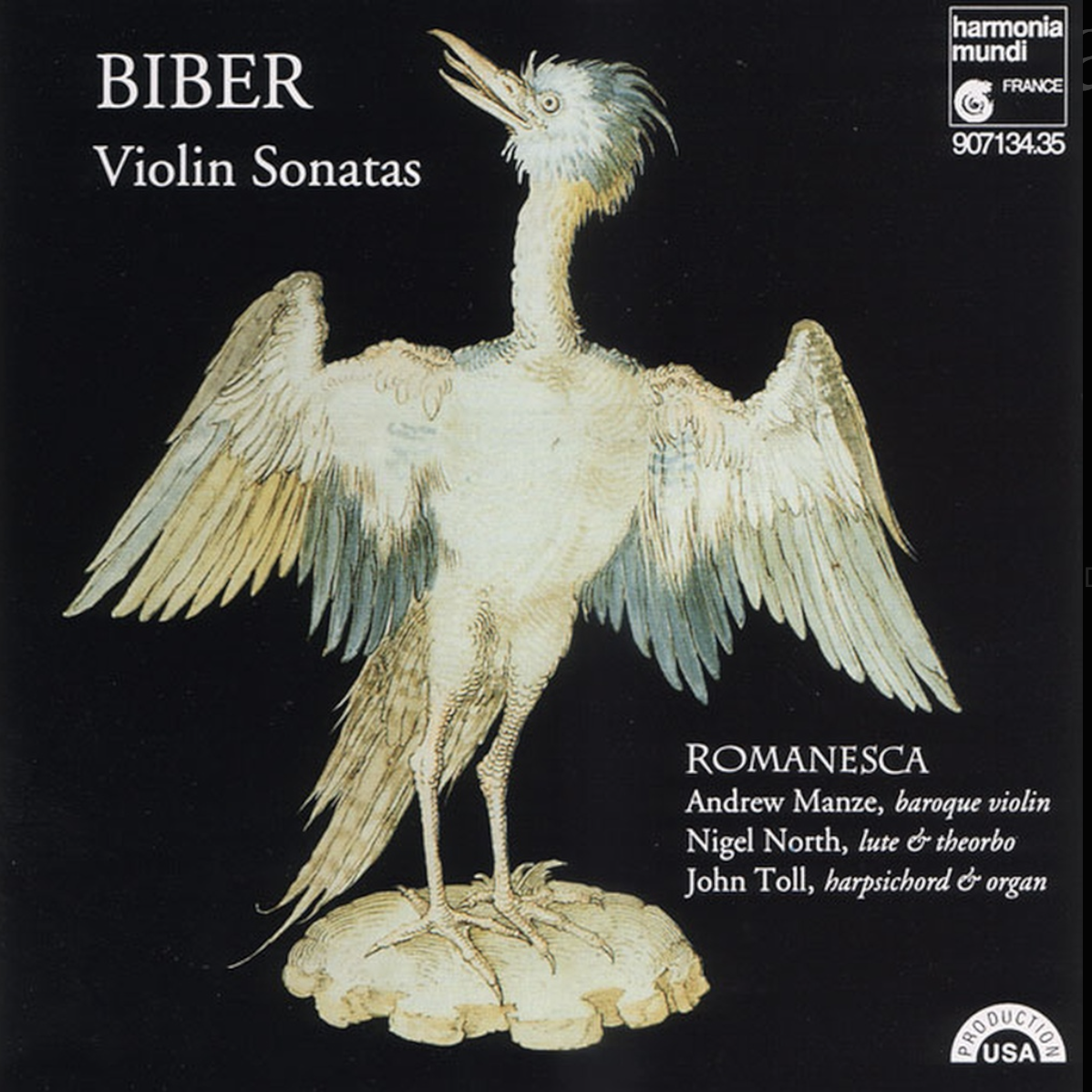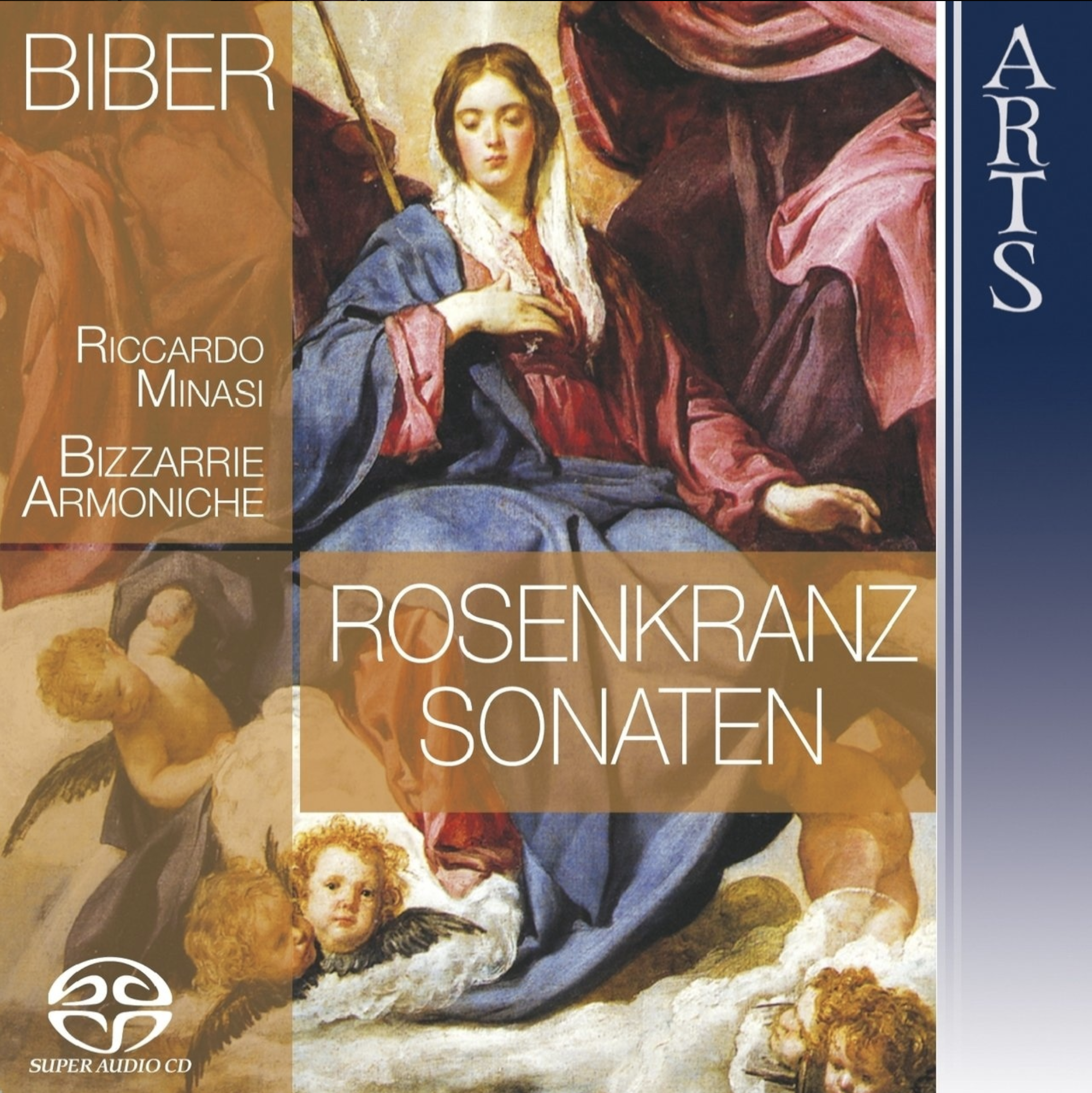Biber’s Mystery Sonatas
This isn't a particular review about one recording, but rather a discussion of a few. I should start by re-telling how I came to find Biber and later, his Rosenkranz-Sonaten also known as the "Mystery Sonatas."
It was Andrew Manze and Romanesca's recording that introduced me to Biber. It was the coolest music I'd heard, I thought. Cool doesn't mean best, but his Sonata representative beguiled everyone I'd play it for, including one of my roommates in my junior year of college who couldn't believe it. "That's a cat!" It was a trip to the House of Guitars in Rochester, NY, where I found Reinhard Goebel's recording of the Mystery Sonatas on Archiv. I was sick that night I got them. I put on headphones. My roommate and I shared a dorm room and he was doing his thing, and I was transported to some other world.
I was taken aback by Goebel's playing. And this incredible music. In 2001, I had this to say, on an earlier version of this website:
Biber's most popular work today is the set of 15 solo sonatas for violin and continuo based on copper-carvings printed in the manuscript that depict scenes from the Bible. Above the religious connotation, they're popular for their virtuosity, fine compositional craft, and engaging use of German-violin effect to evoke easily-rendered emotions. Organized in much the same fashion as his violin sonatas collection of 1681, the Mystery Sonatas too follow a phantasic styling, but increasingly more formalized. Multimovements that at times deserve pauses organize phrases of utter showmanship along others that deserve drawn-out, slow tempi to breathe. The sonatas are capped at the end with a passacaglia for solo violin, a predecessor, we might imagine, to Bach's great Chaconne for solo violin (BWV 1004). Above all else, these sonatas are known for their extreme use of scordatura, a mistuning of strings. The violin here is tuned in many sundry tunings to emphasize the tonality of the work. This makes for difficult playing, intonation, etc. But it also lends a new sound world to the instrument. Only the opening sonata and final passacaglia use the normal g-d-a-e tuning of violin strings. Biber wasn't the only composer to employ scordatura, nor was this his only piece to do so. In listening this past week to the Harmonia Artificioso-Ariosa (performed by Musica Antiqua Köln), I was reminded that many of the pieces there too employ mistuning. The ultimate twister is the last piece, for mistuned viola d'amore. I had a newfound appreciation for the work watching the score on my iPad as I listened. An early recording of Biber's sonatas came to light in a trip to Toronto, Canada. I picked up a recording by one of Goebel's mentors. Again, from 2001: This release is a reissue from the 1968(!) recording of the Mystery Sonatas. Melkus was a mentor and teacher to Reinhard Goebel (why I bought it) and the seeds of modern, fiesty Baroque reconstruction are here for the study by students of modern performing practices. While Baroque ideals are used to construct the performances, to our years today, after 30-some years of scholarship and temperament to a "Baroque ideal," whatever that may mean, we have some 'dated' performances. Heavy violin vibrato, for one, and written-out continuo. Yet, Melkus was a fine player, and his varied continuo team (bassoon, lute, organ, harpsichord, et. al) is certainly a colorful counterpart to the solo violin. I'd hate to think this was my only listen into the world of Biber of his Rosary Sonatas. Yet, as a point of comparison, they make a good listen. The dated sound soon washes away and you begin to enjoy the music. One note: Melkus isn't a real contemplative man. He takes off in some tempos, and some of the continuo is so strong (organ and half a dozen other instruments) that the violin gets drowned out. Surprisingly, the recording quality is not bad. This is part of a series put out by Archiv Produktion of some of their 'original' releases of historical performance. The final passacaglia for me is of special nature, it clocks in at 6:53. Virtuoso, but also some moments of repose. A more 'modern' performance by Andrew Manze clocked in at 10:06. The Manze recording I referenced was the original Romanesca "Biber Sampler" they put out in the 1990s. Manze would go on to record Biber's Mystery Sonatas as one of his last baroque recordings with Richard Egarr. I tried to like it, but it is not my favorite. I can appreciate how Manze views the works as contemplative and even as "prayers." But the music has such potential for energy. Back in 2001, I also wrote about the recording from 1995-2000 by Gunar Letzbor. I knew Letzbor's name from the ranks of Musica Antiqua Köln, but this was the first recording of him for me as a soloist. Letzbor does with his violin things that even my all-time favorite Goebel wouldn't even dream of, and at other times is so poetic with a lack of any expression whatsoever (no vibrato, no urgency in tone) that it would probably make violinist Andrew Manze shudder. So, it was a welcome addition to my collection of violin works performed on original instruments by Biber. There are some exciting bold things being done here, and it is true the violinist is authentic in originality and in many aspects of technique, historically speaking. Good violin sound, if not at times carried to the extreme. But this extremeness is what makes you laugh when you listen, or say "wow, whoa!" as he plays along. Some passages are performed with spit and flash, while others are contemplative. Intonation is good, and all in all, a strong reading of some very difficult works. Take the opening sonata: The first time, the violin so soft, I couldn't hear it! I turned up the volume, really loud, then was blown out of my seat in a Superman-like crescendo. It was sneaky, creepy, and "oh so cool."
I like this rendition. I continued:
The combination of imagination and technical skill here make for a good release. At times, upon secondary listenings, I get the impression some things were done to an extreme. Okay for a live performance, perhaps, but... on a record, it can tire after repeated listenings. I'd recommend this release to die-hard Biber fans (like myself) who want a different, mannered take. The performer notes that his performance on these works is very personal. Continuo support is imaginative and a an exciting component of the performance. Funny, Letzbor was doing what I had wished Manze had done. Oh well, now I have both an extroverted recording and a more conservative one to compare! In May of 2010, I reviewed the rendition by La Tempesta and violinist Patrick Bismuth. I really fell in love with it, and the interpretation. I also around the same time picked up the version on Alpha by Les Veilleurs de Nuit and violinist Alice Piérot. The cover attracted me at first, but the soloist and the close miking was really a thrill. If you can't already tell, Biber's Mystery Sonatas* are a big deal to a fan of Biber. I also picked up several other recordings. One by Pavlo Beznosiuk on Avie, and John Holloway's Gramophone Award-winning version with Tragicomedia on Virgin Veritas. But another really strong performance came from Bizzarie Armoniche** and the Italian violinist Riccardo Minasi.
Minasi likely didn't have the best recorded sound (it lacked the atmosphere of some of the others I've mentioned), but it takes on Biber in the complete opposite way to Manze. First, there's a variety of continuo, and some of it is downright raucous. He treats it, I feel, as a show piece at times, which is conceivable based on the writing. Above all else, he's responding to the musical text in ways I can really appreciate. Above all, Minasi is "agile." The only thing to improve this recording would have been a better balance from among the instruments and a better-capture of the recording space (read: air). Also, my version doesn't include the last chaccone. But my favorite, since coming back from the House of Guitars in 1993, has been this 1991 recording. From my 2001 review:
I can't hold back, I must tell you from the start this is one of the best recordings I own. Great music, absolutely superb performance. This is the crowing achievement in Reinhard Goebel's musical career to date, on record at least. This is Goebel's last solo recording before he retired his left hand. While he has claimed he'll one day perform the Bach Sonatas and Partitas performing the violin (backward) this remains in the Archiv catalog and full of many things to enjoy. No one (that I know) has quite the violin tone Goebel has. It's rich, fat, and astringently Baroque. His gestures are bold, deep, and 'woody.' I am not sure what I mean by using that term, but perhaps 'organic' in a funky 'woodland forest type of way' is what I mean. It's simply that unmatched quality of tone and instrument. Goebel performs on several different violins, with different strings, tunings, and a variety of continuo: lute, cello, organ and harpsichord. The shape of lines, the quality of ornaments, and the ebulient splash of rhythmic verve lends Goebel's listeners an enjoyable time. Upon comparison with Melkus, the big hard bowing gestures are there, but there's more sensitivity, a better overall performance that's marked with even more virtuosity. While not as dramatic as past- Musica Antiqua Köln member Letzbor, this remains for me the definitive recording of Biber, and especially so of the Rosary Sonatas. The press at the time had quoted Goebel reporting he one day hoped to record Bach's Sonatas and Partitas. Hand injuries and health issues followed. It never was to be. I wrote: If the concluding passacaglia is any indication of what me might someday hear in Bach, the hope is great. Clocked in at 6:42, it sounds less rushed than Melkus' reading. At times his hard attack on the violin raise the question regarding just how forcibly he's playing. At times, the pause after a huge triple-stop will allow one to savor the acoustic of the recording. Nevertheless, it's a fabulously close recording. Highly recommended. Some may view this music as religious music, and I should point out that these Mystery of the Rosary sonatas are so named because they were published with depictions of the "15 Mysteries of the Rosary" next to each sonata (one each). While a lot of research has been done to identify how Biber personalized each sonata based on a prayer, these pieces speak to me on a purely non-religious level. The combination of creative motifs, rich harmonies, and violin pyrotechnics all equate to powerful, high quality music. I hope you'll seek out exploring at least one of these recordings if you are new to Heinrich Ignaz Franz von Biber.






